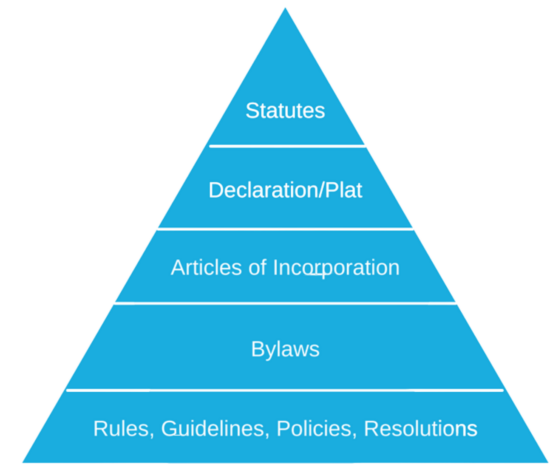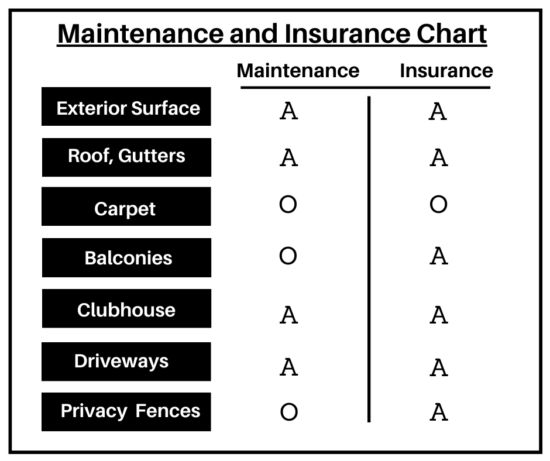If you just got elected to the board or started managing a new community association, the first thing you should do is review your governing documents. Chances are you will be faced with questions, the answers of which are buried in your governing documents. But getting a solid grasp on your documents may seem like an overwhelming task.
For example, if you need to know who is responsible for maintaining the balconies, or whether parking an RV on the street is allowed, or how many people have to be present to take action at a meeting, do you know in which document you will find your answer? It’s difficult to know where to even start. A few markers along the road should help you navigate your way through and bring you to your destination. The following general tips will make the task seem less daunting and give you the confidence to ‘dig in’ to that stack of governing documents.
Understand What Each Document Represents and the Hierarchy
In general terms, each of the governing documents for your community carries varying degrees of authority. And, when there’s inconsistency between and among the documents, the higher one listed on the following chart will control:

Let’s discuss each level of documents and how they work in running an association.
- Statutes
On the very top of the chart, we have the two main statutes that govern Colorado community associations: (1) the Colorado Common Interest Ownership Act (“CCIOA”), and (2) the Colorado Revised Nonprofit Corporation Act (“Nonprofit Act”). With a few exceptions, all community associations are subject to all or some of CCIOA and all of the Nonprofit Act.
With respect to CCIOA, if your association was formed prior to July 1, 1992, then your association is considered a “pre-CCIOA” association, subject only the provisions listed in C.R.S. §38-33.3-117 of CCIOA. If your association was formed on or after July 1, 1992, your association is a post-CCIOA association, subject to all of CCIOA.
It is very important to know these statutes, because they may serve to fill gaps when your governing documents are silent on a particular issue, or provide clarification where clarification is needed, or give the board authority for certain actions and limitations on others, or, most importantly, supersede the language in your governing documents.
For example, if your declaration states that no signs are allowed on the lot except for one “For Sale/For Rent” sign, CCIOA will supersede and require you to allow other types of signs. If your Bylaws states that it takes 25% of the owners to sign a petition to call a special meeting, CCIOA will override as it places a 20% cap on such signatures. If your bylaws are silent on the procedures for board action by email, the Nonprofit Act establishes those procedures.
Also, while both CCIOA and the Nonprofit Act are at the top of the hierarchy chart, this does not mean that every single provision in the statutes will override the language in your governing documents. Some statutory provisions might provide default language for a particular issue, but defer to the governing documents if they speak to the same issue. For example, if your Bylaws do not specify a quorum requirement, CCIOA fills in the gap with a 20% quorum requirement. Other provisions will state that, regardless of your governing documents, CCIOA or the Nonprofit Act controls.
Boards and managers must know the statutes and keep up to date on legislative changes every year, so they are enforcing the documents in compliance with the law. Look to the Legislative Tracker on our website, to see the most recent five years of laws applicable to Colorado community associations.
- Declaration/Plat
The declaration and plat or map are considered the same document so they enjoy the same level on the hierarchy chart. Both are recorded with the Clerk and Recorder’s office of the county in which the community is located, and together these documents serve to create the common interest community.
The declaration (a.k.a. CC&Rs, Covenants, etc.) has the most ‘meat’ of all the documents as it contains the provisions that affect your rights and obligations in the community. If you’re looking for answers related to use of property (i.e., rental restrictions, parking requirements, pet regulations, etc.), or whether the association or owner is required to maintain or insure a certain component, or the obligation to pay assessments and the general remedies for non-payment, or the board’s authority to take certain actions, look to the declaration.
The plat identifies the property that is subject to the declaration, and could help you with questions such as unit boundaries, whether a component is a limited or general common element, maintenance obligations, whether the streets are public, and easement rights.
- Articles of Incorporation
The articles of incorporation bring an association into corporate existence. They are filed with the office of the Colorado Secretary of State and set forth the general purposes of the association, qualifications for being a member, certain board member provisions, and dissolution requirements. They also include (or should include) a provision limiting the personal liability of board members. Look to the Articles if you have questions on the general purposes of the association or how to dissolve the association.
- Bylaws
The bylaws can be considered the procedural manual of the association. They set forth the procedures and rules for the governance of the association. Look to the bylaws if you need answers on meeting notice and other meeting requirements, election of directors, general record-keeping requirements, qualifications for serving on the board or as an officer, owner rights at board meetings, and other such procedural questions.
- Rules and Regulations, Design Guidelines, Policies, Resolutions
Look to any of these documents if you’re searching for more detailed explanations, clarifications and definitions of restrictions and authorities already found in the declaration, bylaws and articles of incorporation.
- Rules and regulations are statements of required behavior or action, the violation of which will result in a penalty (i.e., pet rules, parking rules, swimming pool and other rec facility rules, etc.).
Often rules and regulations will clarify what is already stated in the declaration. For example, your declaration might state that each lot may have a “reasonable number of household pets”, and your rules and regulations might define the ambiguous terms “reasonable number” and “household pets.”
- Design or architectural guidelines are simply rules and regulations that are focused on one category: architectural and design modifications. They might clarify timeframes and requirements for submission of architectural plans, specify height/material/color requirements for certain improvements, require steps to follow when completing the improvement.
- Policies are course of actions related to a particular category. For example, CCIOA requires boards to adopt a collection policy specifying the course of action the association will take in the collection of delinquent assessments, including timeframes for payments, late fees and interest, payment plan terms, notice and posting requirements, and other such procedures. Check out our webinar on Required and Recommended Policies for various policies both required and recommended pursuant to Colorado law.
- Resolutions are simply a formal way to document board decisions. For example, a board might “resolve” to adopt a parking policy, or to define the term “commercial vehicle”, or to enter into a loan, or to adopt a schedule of fines.
Keep in mind that each of the above-discussed documents are listed in terms of hierarchy, and that the lower level of document may not contradict or conflict with anything found in the higher level of governing document. For example, if the articles of incorporation state that the association shall be run by a three-member board, but the bylaws state that there shall be a five-member board, the articles will trump.
Get to Know Your Definitions
A key to gaining a solid understanding of your association’s governing documents is to review the defined terms. For instance, you might be wondering who is responsible for repairing the damage caused by a broken water line. If the Declaration states that the owner repairs the unit and the limited common elements, and the association maintains the general common elements, you will have to review the definitions for “Unit”, “Limited Common Element”, and “General Common Elements”, so you can understand the scope of responsibilities.
Tab the definitions section of your declaration (usually found at or near the beginning of the document), or other provisions where commonly used terms are defined, as you will have to refer to them regularly. And, keep in mind that if you find a capitalized term or phrase in a particular section, that term or phrase will usually be defined somewhere in the document. And, that definition must be taken into account when analyzing the provision in question.
Understand the Difference Between Maintenance, Repair, Replacement and Insurance
One area that seems to trip up some of the more adventurous reviewers of governing documents is the difference between the requirements to maintain, repair, replace or insure. Do not assume the foregoing responsibilities go hand-in-hand. In some cases, the party responsible for maintaining a certain element may not be responsible for replacing it or insuring it in the event of catastrophe.
As an example, the owner might be responsible for cleaning and maintaining the balcony, but the association might be required to replace and/or insure it. Each of the applicable maintenance and insurance provisions of the declaration must be reviewed carefully and without any presuppositions regarding the seemingly natural connection between various duties.
Best practice is to adopt a Maintenance and Insurance chart to clearly define the obligations of the association and the owner, so each party can properly budget for their responsibilities.

If They Are Broken, They Can Be Fixed
If the above tips for reviewing and understanding your governing documents were not helpful because your documents are exceptionally confusing, poorly written, or so out of date that you’re tired of flipping back and forth between the document and the statute for controlling language, … keep in mind they can be amended!
Each of the governing documents in question can be amended, either in whole or in part, pursuant to the procedures stated in the document itself, subject to any superseding requirements under CCIOA and the Nonprofit Act. The amendment process can be tricky, however, and your association will want to make sure that any new amended provisions are properly drafted, have the meaning that is intended, are properly approved and legally recorded. If you’re considering amendment, be sure to check out our webinar on Amending Your Governing Documents for tips.
Hopefully the above has provided some valuable tips to understanding and interpreting your association’s governing documents. For more assistance please reach out of any of our Altitude attorneys are [email protected] or 303-432-9999.